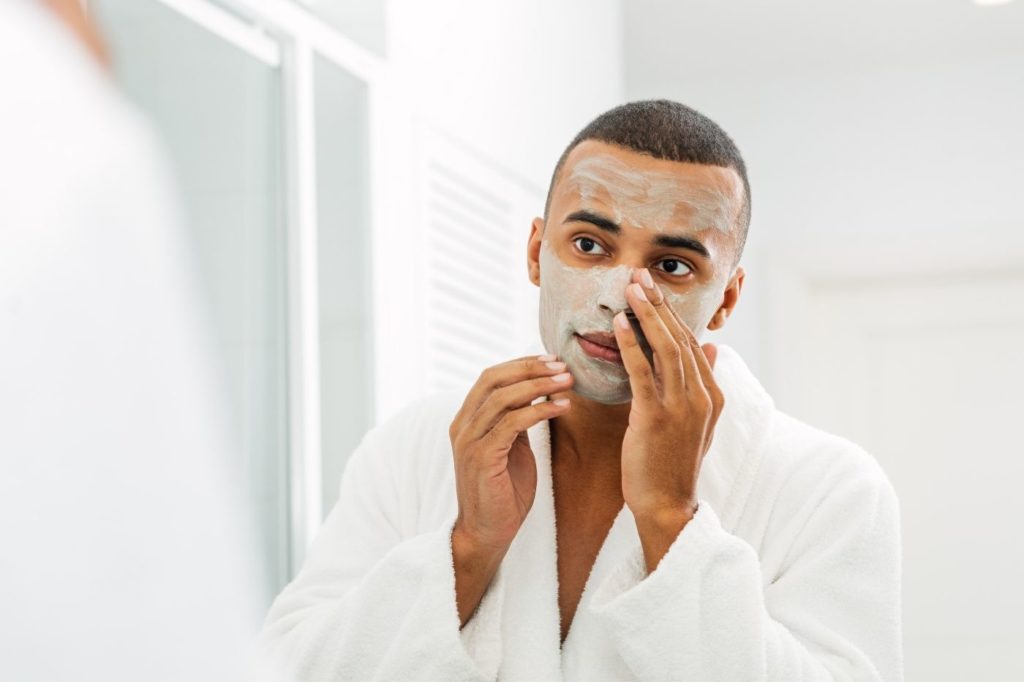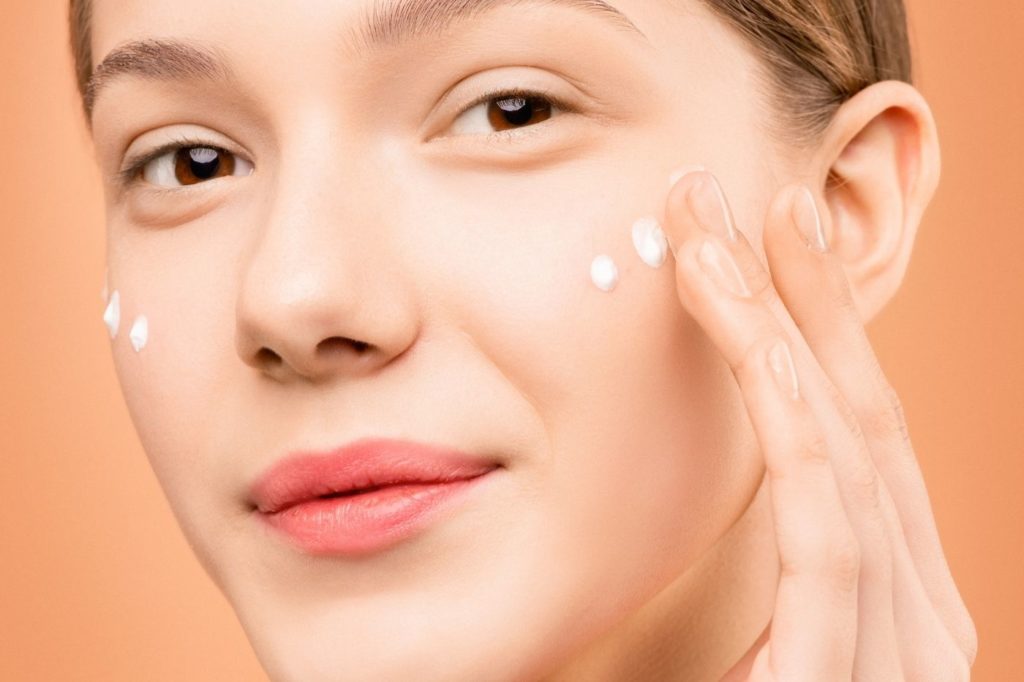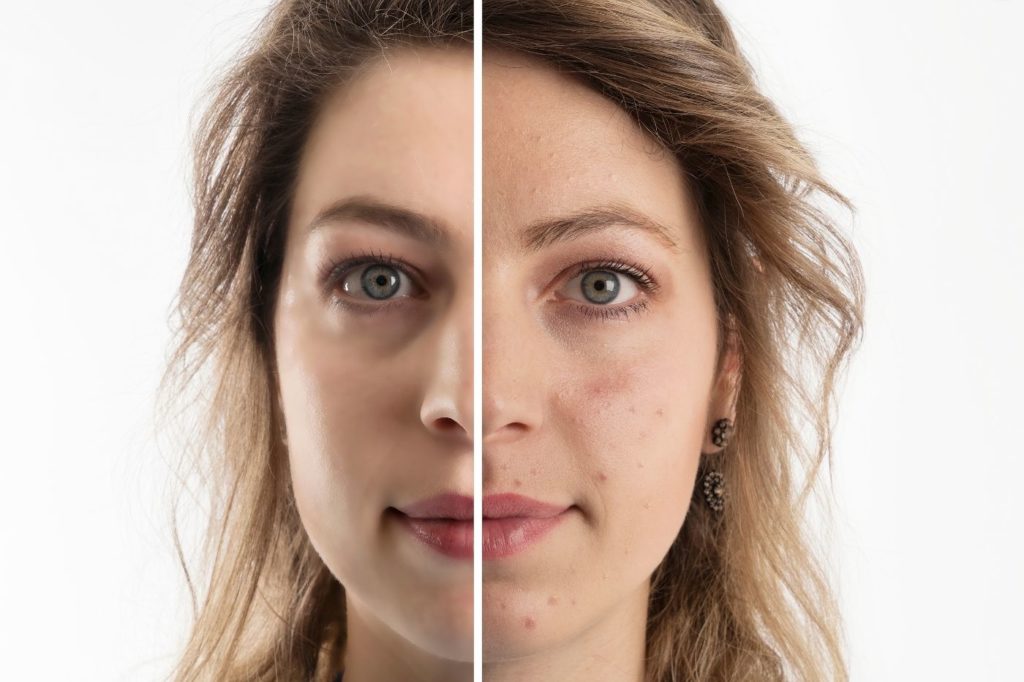
And just like that…it’s another morning where there is yet another random pimple on the jawline. Ugh..when does it stop?
Well, 3 anti-androgens for pimple breakout may be just what you’re looking for: DIM, saw palmetto, and Vitex.
These natural anti-androgens can reduce or eliminate hormonal pimple breakout in many cases as they balance hormones and reduce pimple breakout. Read on to understand their powerful effects.
What are anti-androgens?
To define an anti-androgen, let’s start with what an androgen is.
An androgen is a sex hormone naturally produced in the human body. Androgen and testosterone are often referred to as “male” hormones, while estrogen and progesterone are “female” hormones.
Nevertheless, all people have all of the androgens, just different ratios of them.
How do androgens cause pimple breakout? Androgens can cause pimple breakout by triggering sebaceous glands in the skin to overproduce oil, which clogs pores and hair follicles, inflames the skin, and feeds Cutibacterium, a key microbe in pimple breakouts.
Women tend to have lower androgen levels, but when the proportion of androgens to other hormones is imbalanced, symptoms such as pimple breakout can result. Heightened androgen production in women can come from a number of factors, including:
- Polycystic ovary syndrome (PCOS)
- Congenital adrenal hyperplasia
- Ovarian tumors
- Cushing’s disease
- Congenital adrenal hyperplasia
As a dermatologist, I have seen that balancing the androgen levels can cause a breakthrough in pimple breakout treatment.
That’s where my favorite anti-androgens come into play, swooping in to save the day like the hero of a Hallmark romance! Anti-androgens balance out the overproduction of androgens.

What are anti-androgens used for?
Anti-androgens are used to block the effects of excess androgen in the body.
Scientifically, most anti-androgens that affect pimple breakout inhibit dihydrotestosterone (DHT) or alpha-reductase from binding to the androgen receptors in sebaceous glands. Do DHT blockers help pimple breakout? Yes, DHT blockers help pimple breakout by preventing androgens from locking onto their targets.
With the receptors blocked and no place to call home, androgens can’t wreak havoc on the skin. Many can also reduce inflammatory cytokine production, which means they can lower the inflammation that often comes with pimple breakout.
Heightened levels of androgens in women, or hyperandrogenism, can lead to hormonal pimple breakouts. Beyond hyperandrogenism can also cause:
- Androgenetic alopecia (balding)
- Seborrhea (inflamed skin)
- Hirsutism (irregular hair growth), and
- High blood pressure (hypertension)
More seriously, long-term hormonal imbalances can cause serious issues like prostate cancer and breast cancer if not treated. Beyond your skin, it’s always in your best interest to balance your hormones.
While there are wonderful hormonal therapy options like a low-dose contraceptive pill, spironolactone, Cyproterone acetate, or a topical antiandrogen cream like clascoterone, there are also more holistic ways to balance androgen production for hormonal breakouts.
You may be wondering: how do I naturally balance androgens? To naturally balance androgens, sometimes adding in options such as DIM, saw palmetto, or Vitex can be helpful.

DIM for pimple breakout
So, how do you get better control over androgen pimple breakouts? To address androgen pimple breakouts, DIM can be a great natural starting point to curb sebum production. DIM occurs naturally in cruciferous vegetables like broccoli, but also comes in capsule form.
DIM is a natural anti-androgen, binding to the androgen receptors and blocking excess androgen from attaching to those proteins. Not only that, but an overproduction of testosterone can sometimes be converted to estrogen — causing even more hormone havoc.
Nevertheless, the benefits of DIM don’t stop there. DIM also assists the liver in breaking down excess estrogen and stops the body from converting surplus testosterone to estrogen. This further evens out hormonal levels in the body.
DIM can also reduce the production of inflammation-causing cytokines. Pimple breakouts are an inflammatory condition, so this may also help with reducing breakouts.
In short, DIM can assist with both estrogen-related and androgenic issues, making it a star in the treatment of pimple breakouts, as I’ve written before.
Saw Palmetto for pimple breakout
Saw palmetto is often recommended by functional healthcare providers for pimple breakouts because it helps decrease some testosterone from becoming DHT, it’s more potent form, which can worsen pimple breakouts.
It can also decrease inflammation while supercharging the immune system to fight infection or other illness.
Saw palmetto also contains several fatty acids like laurate, palmitate, oleate, and linoleate that keep the skin hydrated and nourished while reducing irritation. The effects of this can go beyond hormone regulation to skin rehabilitation.
This androgen inhibitor also works wonders in reducing hormonal hair loss. Saw palmetto can be taken orally, applied topically with a carrier oil to the skin, eaten in its berry form, or used as an ingredient in topical creams.
Vitex for pimple breakout
Vitex, also called chaste berry, is a long-used natural remedy for PMS pain and breast tenderness.
One study showed an improved hormone balance in women who took Vitex over those in the placebo group. While we are still researching the full effects of Vitex, preliminary research shows promise as an pimple breakout treatment.
The way Vitex works for pimple breakout is different from DIM or saw palmetto. In particular, Vitex limits the release of a hormone called prolactin.
Prolactin is a “modulating” hormone, similar to cortisol. It’s released in response to stress, pregnancy, and even injury. But too much prolactin for too long can lead to a wide variety of skin problems, including pimple breakouts.
But this isn’t just a hormone vs. skin issue. Prolactin impacts skin health by acting on the nervous system, creating a sort of “loop” between the endocrine system, nervous system, and skin.
That’s one way Vitex impacts pimple breakout, PMS, PMDD, and many more hormonal issues — it stimulates the release of dopamine (the “happy hormone”). When dopamine is released, your mood and mental health often improves and prolactin production is limited.
Finally, Vitex also seems to act on acetylcholine and opioid receptors. That’s why it’s so useful for reducing inflammatory pain.
DIM vs. Saw Palmetto vs. Vitex
These 3 anti-androgens can all help reduce pimple breakouts, but they work differently.
DIM, saw palmetto, and Vitex all:
- Suppress androgen hormone activity
- Reduce inflammation
But here’s where each of them stands out:
- DIM may curb sebum production and control excess estrogen production for powerful hormone-balancing and pimple breakout-fighting benefits.
- Saw palmetto blocks testosterone-to-DHT conversion, which means it protects from pimple breakouts and hormonal hair loss (in both men and women). It also has skin-hydrating properties.
- Vitex limits the production of prolactin, which is released in large amounts when you experience stress, become pregnant, or start lactating. It creates a healthier connection between the skin, nervous system, and endocrine system. It may also improve your mood and reduce pain responses.
Precautions for Using DIM, Saw Palmetto, and Vitex for pimple breakouts
Before you rush out to buy these three recommendations, sit down and have a real conversation with your dermatologist about the cause of your pimple breakouts. Not all pimples are hormonally related, and some have unexpected causes.
Anti-androgens are also known to cause side effects like:
- Lowered sex drive
- Raised liver enzyme levels
- Hair loss on the face and body
- Hepatitis
- Breast tenderness
- Diarrhea
A few other considerations:
- Be sure to tell your dermatologist about any other medication you’re on, including combined oral contraceptives or other prescriptions.
- It’s not advisable to take any anti-androgens if you are pregnant or breastfeeding.
- If you’re thinking of taking DIM, be sure to start with the lowest dose possible and only increase after you have taken it for 2-3 months. It has the potential to negatively affect your menstrual cycle.
- Saw palmetto, DIM, and Vitex may not be suitable for people under 18.
- When Vitex stimulates dopamine release, you may produce lower levels of TSH (thyroid-stimulating hormone) as a result. If you have thyroid problems, talk to your doctor before taking Vitex.
When I work with those who have hormonal pimple breakouts, I take the time to review their individual case, the root issues of their pimple breakout breakouts, and what treatments have worked or not worked for them in the past. Only then do I make a recommendation as to which of these anti-androgens may help reduce their breakouts.
Should you try DIM, Saw Palmetto, or Vitex?
Curious to learn more? It may be time to ask your dermatologist about your options for androgen inhibition. However, it’s not possible to tell any individual what’s right for them without a proper medical consultation. If you think these anti-androgens for pimple breakout options could help you, chat with your dermatologist today!
Sources
- Bhatia, A., Maisonneuve, J. F., & Persing, D. H. (2004, June). Propionibacterium acnes and chronic diseases. In The Infectious Etiology of Chronic Diseases: Defining the Relationship, Enhancing the Research, and Mitigating the Effects: Workshop Summary., Knobler, SL et al.(eds.) (pp. 74-80). Full text: https://www.ncbi.nlm.nih.gov/books/NBK83685/
- Azziz, R., Carmina, E., Dewailly, D., Diamanti-Kandarakis, E., Escobar-Morreale, H. F., Futterweit, W., … & Witchel, S. F. (2006). Criteria for defining polycystic ovary syndrome as a predominantly hyperandrogenic syndrome: an androgen excess society guideline. The Journal of Clinical Endocrinology & Metabolism, 91(11), 4237-4245. Abstract: https://pubmed.ncbi.nlm.nih.gov/16940456/
- El-Maouche, D., Arlt, W., & Merke, D. P. (2017). Congenital adrenal hyperplasia. The Lancet, 390(10108), 2194-2210. Abstract: https://pubmed.ncbi.nlm.nih.gov/28576284/
- Lause, M., Kamboj, A., & Faith, E. F. (2017). Dermatologic manifestations of endocrine disorders. Translational pediatrics, 6(4), 300. Abstract: https://pubmed.ncbi.nlm.nih.gov/29184811/
- Thomson, C. A., Chow, H. S., Wertheim, B. C., Roe, D. J., Stopeck, A., Maskarinec, G., … & Galons, J. P. (2017). A randomized, placebo-controlled trial of diindolylmethane for breast cancer biomarker modulation in patients taking tamoxifen. Breast cancer research and treatment, 165(1), 97-107. Abstract: https://pubmed.ncbi.nlm.nih.gov/28560655/
- Tesch, B. J. (2003). Herbs commonly used by women: an evidence-based review. American journal of obstetrics and gynecology, 188(5), S44-S55. Abstract: https://pubmed.ncbi.nlm.nih.gov/12748451/
- Verkaik, S., Kamperman, A. M., van Westrhenen, R., & Schulte, P. F. (2017). The treatment of premenstrual syndrome with preparations of Vitex agnus castus: a systematic review and meta-analysis. American Journal of Obstetrics and Gynecology, 217(2), 150-166. Abstract: https://pubmed.ncbi.nlm.nih.gov/28237870/
- Westphal, L. M., Polan, M. L., & Trant, A. S. (2006). Double-blind, placebo-controlled study of Fertilityblend: a nutritional supplement for improving fertility in women. Clinical and experimental obstetrics & gynecology, 33(4), 205-208. Abstract: https://pubmed.ncbi.nlm.nih.gov/17211965/
- Yarnell, E., & Abascal, K. (2006). Herbal medicine for acne vulgaris. Alternative & Complementary Therapies, 12(6), 303-309. Abstract: https://www.liebertpub.com/doi/abs/10.1089/act.2006.12.303?journalCode=act
- Foitzik, K., Langan, E. A., & Paus, R. (2009). Prolactin and the skin: a dermatological perspective on an ancient pleiotropic peptide hormone. Journal of Investigative Dermatology, 129(5), 1071-1087. Full text.

